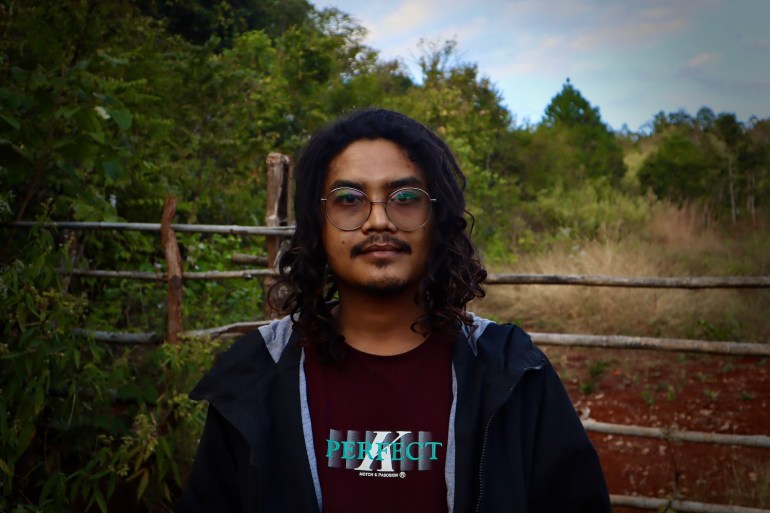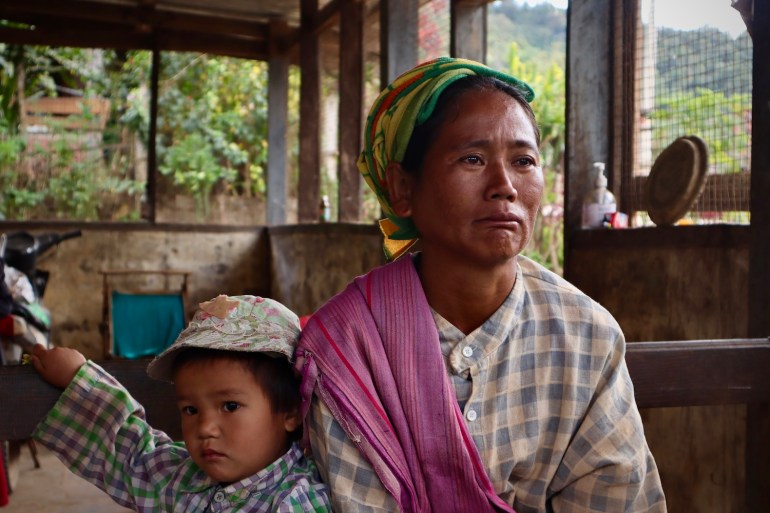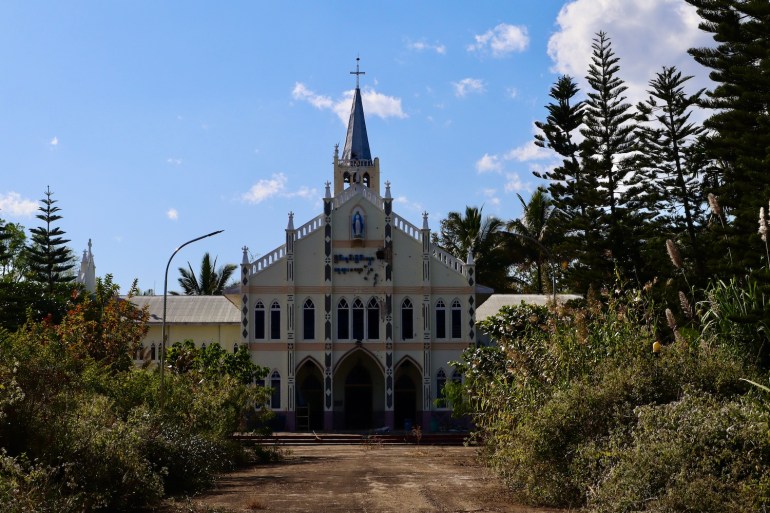Kayah State, Myanmar – On December 28, in his clinic in Myanmar’s eastern Kayah State, Dr Oak wrapped up a routine check on a pregnant woman and removed some non-threatening shrapnel from the leg of a resistance fighter.
Exactly two years earlier, he was living a nightmare, examining the charred remains of 33 civilians brutally killed by the Myanmar military.
“Before, when I was working in the hospital, I might see one or two bodies at a time. But when I saw that many bodies at once, and understood the cruelty of the way the military killed them, I felt devastated and terrified,” he told Al Jazeera. “I felt so sorry for their family members because they can’t even identify their loved ones and say a proper goodbye.”
Dr Oak, who asked to be identified by a nickname to protect his family, has been living in Kayah State since December 15, 2021. After the military seized power in a coup in February of that year, he quit his job at a government hospital in his native Ayeyarwady Region and joined a mass strike of civil servants known as the Civil Disobedience Movement.
After a few months of participating in street protests and then hiding in safe houses in Ayeyarwady and Yangon, he headed to Kayah intending to join the burgeoning armed resistance.
“In the beginning, I was planning to get a gun and fight. I just wanted to fight the military so badly. But when I arrived here, they already had so many soldiers but they really needed doctors. So I realised this was the best way for me to help,” he said.

The victims Dr Oak examined that day were killed in Moso village in the Hpruso Township, in what was dubbed the Christmas Eve Massacre after the military stopped several vehicles travelling along a major road connecting the towns of Hpruso and Demoso, allegedly detaining, executing and burning those inside. Some of those killed were reportedly fleeing from nearby clashes, while others lived in the area.
‘I am still waiting’
Much of Kaya’s population is Roman Catholic and Christmas is the most important day of the year. But Khin Lone’s family was so poor that her husband could not afford to take Christmas Eve off. He accepted a job to help a farmer harvest bamboo shoots that day, a task that would typically pay about 5,000 kyat – less than $3.
She never saw him again.
Soon after her husband had left for work, Khine Lone’s neighbours came running through the village, screaming that the military was coming. But with four children, including a 10-month-old baby, it was difficult for Khin Lone to leave on her own.
“I called him and he answered the phone and said, ‘OK, I’m coming soon,’ so I stayed at home waiting for him,” she said. “I’m still waiting for him.”
Eventually, other villagers came to help and Khin Lone and her children escaped into the forest, where they hid for two days before moving to a camp for internally displaced people where they remain today.
The 35-year-old widow has only been back to Moso once since the killings – on December 24 last year when she left flowers on the burned-out wreckage of the now-rusting cars and prayed for the dead.
It is a risky journey. The site of the killings lies in a no man’s zone, just 8km (5 miles) from where the military remains holed up in Hpruso town but also a few kilometres from the last resistance-manned checkpoint.
Still, the situation represents a dramatic shift in the Myanmar conflict over the past two years, with resistance groups able to freely navigate rural parts of Hpruso and the neighbouring Demoso Township, while the military is largely confined to a few towns and military bases.

Moso now represents the outer limit of the military’s reach in Hpruso and the killing a final spasm of violence before it lost control.
A logistics officer from the Karenni Nationalities Defence Force (KNDF), an armed group formed after the coup, said resistance groups had long used the major road on the other side of Moso village to transport goods and troops.
He said the military might have attacked the village to punish them for supporting the resistance. For decades, the military has been accused of using collective punishment against civilian communities – known as “four cuts” – as part of its campaigns against ethnic armed groups.
Military-controlled media did not acknowledge any civilian casualties and claimed that the convoy included resistance fighters who opened fire first.
Khin Lone recalled that for the first two days, the other villagers were too afraid to tell her what she already knew in her heart and sought to reassure her that her husband might still be alive.
“In my mind, I already knew it was impossible but then I turned around and lied to my children and said he is working somewhere else and will come back soon,” she said.
‘I ran’
Nwe Lay was more fortunate.
At the time of the attack, he was a member of a military-aligned Border Guard Force (BGF) called the Karenni National People’s Liberation Front (KNPLF). Starting in 2009, the military demanded that ethnic armed groups submit to its chain of command as BGFs. Those that complied, like the KNPLF, were rewarded with lucrative business deals; those that refused faced new military offensives.
Nwe Lay was also a farmer and on the day of the killings, he was on his way to check on his herd of cows and buffaloes.
“I saw soldiers and they just started shooting at me right away, so I ran,” he said, catching a glimpse of what was unfolding as he escaped.

“I saw they were detaining and rounding people up and saw many cars stopped on the side of the road,” he recalled.
What happened next, according to Dr Oak, was horrific.
“Most of the bodies were totally burned beyond recognition,” he said. “The bodies that weren’t burned, we could see that they had their hands tied and their mouths gagged and a gunshot wound to the forehead. But mostly they were totally burned.”
Dr Oak said he identified 33 bodies and at least six were female. He was unable to determine the sex of two of the dead because of the extent of the injuries.
He said only four of the victims had burn marks on their trachea – which could have been from smoking – indicating that most, if not all, of the victims had been killed before they were burned rather than being burned alive.
Some have suggested this was done to cover up the way the victims were restrained and then executed. The KNDF has previously said it was conducting an investigation and that some of the soldiers involved have since been captured.
But KNDF chairman Khun Bedu told Al Jazeera that he could not confirm who was responsible or whether they were in custody. He said the investigation had been stalled by continued instability. “Due to [the] war escalating, we cannot provide any further information,” he said, acknowledging the victims had yet to see justice.
Four other troops from Nwe Lay’s BGF unit were also killed, reportedly for trying to mediate.
“When I got back to the village and found the BGF officer, he said he sent four soldiers to go check on the situation,” Nwe Lay recalled. “I thought, they will definitely be killed.”
His first thought was to go home and grab his gun but he knew there were too many soldiers to take on.
“I really wanted to kill them,” he said.
The military tied up the four men and shot them in the head, the KNDF said in a statement on the day of the attack, but the BGF continued to cooperate with the military even after the killings.

Nwe Lay was so furious, he quit his post in disgust.
Changed allegiance
In July 2023, however, the BGF dramatically switched sides, helping the resistance coalition seize control of the Mese Township in Kayah’s far south. During Al Jazeera’s visit to Mese in December and January, resistance forces were in control of the main town, major roads, border crossings with Thailand and river ports.
“Without the KNPLF switching sides, for sure we would not have been able to take control of Mese Township,” said the KNDF logistics officer.
After the KNPLF turned on the military, Nwe Lay rejoined the group but still feels some resentment.
“I’m happy to see it and I take courage from it but I think it should have happened a lot earlier,” he said of the KNPLF’s decision.
Even though she now lives in an area controlled by the resistance, Khin Lone said the family lives with the constant threat of air strikes and long-range artillery.
This is no idle fear.
The military has routinely used air strikes on civilian targets, including schools and hospitals, killing more than 500 civilians since the coup according to local monitors.
On the first anniversary of the Moso killings, the United Nations Independent Investigative Mechanism for Myanmar said it had documented “evidence of an array of war crimes and crimes against humanity”, including the Christmas Eve Massacre.
More incidents have occurred since but with the anti-coup resistance gaining more ground since an alliance of armed groups launched a major offensive at the end of October, the military now faces its biggest challenge to its rule in decades and its days of impunity may be numbered.

For Khin Lone, while it is painful for her to relive the memory of the killings, she feels obligated to tell her husband’s story.
“I want everybody to know how cruel the military is and the way they killed innocent people like my husband and so many others,” she said. “It’s been two years and the soldiers have still never faced justice for what they’ve done.”









